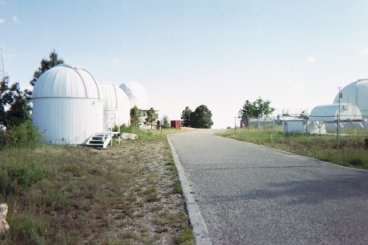Mount Lemmon Observing Facility

The Mount Lemmon Observing Facility (MLOF) was built in 1970 and is located near Tuscon, AZ. After the success of the O'Brien Observatory in Minnesota, Wayne Stein, Fred Gillett, Nick Woolf, and Ed Ney sought to build a larger, infrared-optimized telescope, and place it in a dry, high-altitude location. Bob Gehrz led the enterprise of surveying various locations, and ultimately, Mount Lemmon was settled upon because of its proximity to existing University of Arizona facilities. MLOF is home to a 60-inch, f/15, infrared-optimized Dahl-Kirkham Cassagrain telescope. For its first 19 years, the telescope had to be operated manually, but in 1989, it was modified by Gehrz and Terry J. Jones to be completely automated under computer control with the capability of being remotely operated by observers anywhere in the world using a phone modem.
Early Observations and Discoveries at MLOF
- The first large-scale census of the infrared radiation from RV Tauri stars and other evolved Post Main Sequence (PMS) stars
- The first comprehensive survey of the SEDs of pre-Main Sequence stars (Cohen 1973 a, b, c, and d)
- Cohen, 1973. Infra-red observations of young stars I. Stars in young clusters.
- Cohen, 1973. Infra-red observations of young stars II. T Tau stars and the ORI population.
- Cohen, 1973. Infrared observations of young stars III. Nebulous emission-line stars.
- Cohen, 1973. Infrared observations of young stars IV. Radiative mechanisms and interpretations.
- The first attempts to obtain systematic 7-14 μm CVFW spectroscopy of stellar sequences
- Merrill and Stein, 1976. 2-14 µm stellar spectrophotometry I. Stars of the conventional spectral sequence.
- Merrill and Stein, 1976. 2-14 µm stellar spectrophotometry II. Stars from the 2 MU M infrared sky survey.
- Merrill and Stein, 1976. 2-14 µm stellar spectrophotometry III. AFCRL sky survey objects.
- The first attempt to detect the 10 μm radiation from globular cluster cores
- Cohen and Fawley, 1974. Ten micron observations of globular clusters.